Organisational Behaviour Essay: Big Five Personality Dimensions
VerifiedAdded on 2022/09/18
|6
|1685
|21
Essay
AI Summary
This essay examines the role of personality in organisational behaviour, focusing on the "Big Five" personality dimensions: conscientiousness, neuroticism, extraversion, openness to experience, and agreeableness. The essay begins with an introduction outlining the structure and purpose, followed by a detailed discussion of each dimension, including definitions and examples. The essay then utilizes the Big Five theory to identify potential areas for performance improvement, based on the personality assessment conducted in workshops. The author explains how specific personality traits can impact academic and work-related performance, drawing on Organisational Behaviour theories to support the analysis. The essay concludes by summarizing the key points and emphasizing the importance of understanding personality dimensions in fostering effective organisational behaviour. The essay utilizes various academic sources to support the arguments made and improve the quality of the content. The essay aims to analyse the personality dimensions in the workplace.

Running Head: ORGANISATIONAL BEHAVIOUR
ORGANISATIONAL BEHAVIOUR
Name of the Student
Name of the University
Author Note:
ORGANISATIONAL BEHAVIOUR
Name of the Student
Name of the University
Author Note:
Paraphrase This Document
Need a fresh take? Get an instant paraphrase of this document with our AI Paraphraser
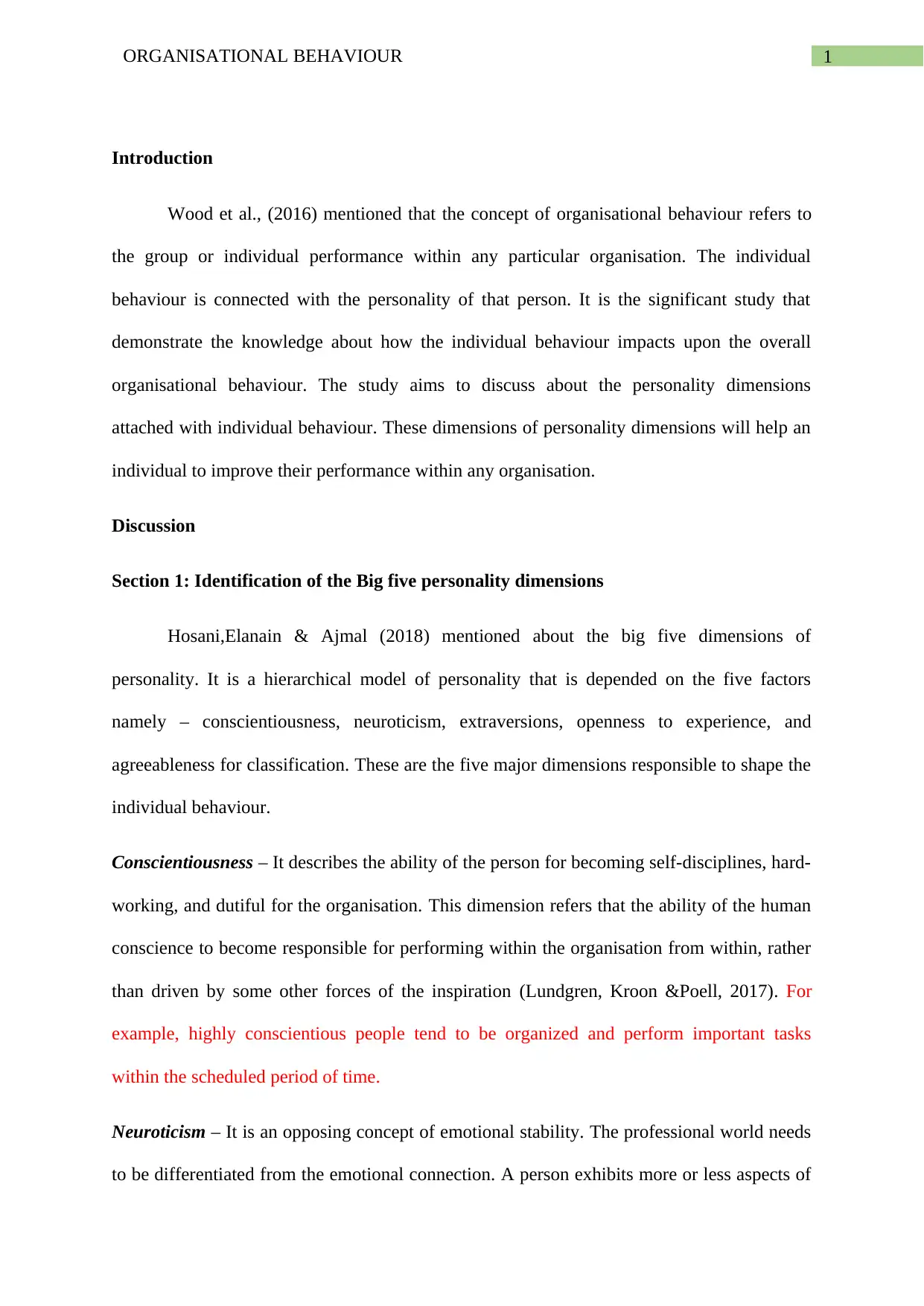
1ORGANISATIONAL BEHAVIOUR
Introduction
Wood et al., (2016) mentioned that the concept of organisational behaviour refers to
the group or individual performance within any particular organisation. The individual
behaviour is connected with the personality of that person. It is the significant study that
demonstrate the knowledge about how the individual behaviour impacts upon the overall
organisational behaviour. The study aims to discuss about the personality dimensions
attached with individual behaviour. These dimensions of personality dimensions will help an
individual to improve their performance within any organisation.
Discussion
Section 1: Identification of the Big five personality dimensions
Hosani,Elanain & Ajmal (2018) mentioned about the big five dimensions of
personality. It is a hierarchical model of personality that is depended on the five factors
namely – conscientiousness, neuroticism, extraversions, openness to experience, and
agreeableness for classification. These are the five major dimensions responsible to shape the
individual behaviour.
Conscientiousness – It describes the ability of the person for becoming self-disciplines, hard-
working, and dutiful for the organisation. This dimension refers that the ability of the human
conscience to become responsible for performing within the organisation from within, rather
than driven by some other forces of the inspiration (Lundgren, Kroon &Poell, 2017). For
example, highly conscientious people tend to be organized and perform important tasks
within the scheduled period of time.
Neuroticism – It is an opposing concept of emotional stability. The professional world needs
to be differentiated from the emotional connection. A person exhibits more or less aspects of
Introduction
Wood et al., (2016) mentioned that the concept of organisational behaviour refers to
the group or individual performance within any particular organisation. The individual
behaviour is connected with the personality of that person. It is the significant study that
demonstrate the knowledge about how the individual behaviour impacts upon the overall
organisational behaviour. The study aims to discuss about the personality dimensions
attached with individual behaviour. These dimensions of personality dimensions will help an
individual to improve their performance within any organisation.
Discussion
Section 1: Identification of the Big five personality dimensions
Hosani,Elanain & Ajmal (2018) mentioned about the big five dimensions of
personality. It is a hierarchical model of personality that is depended on the five factors
namely – conscientiousness, neuroticism, extraversions, openness to experience, and
agreeableness for classification. These are the five major dimensions responsible to shape the
individual behaviour.
Conscientiousness – It describes the ability of the person for becoming self-disciplines, hard-
working, and dutiful for the organisation. This dimension refers that the ability of the human
conscience to become responsible for performing within the organisation from within, rather
than driven by some other forces of the inspiration (Lundgren, Kroon &Poell, 2017). For
example, highly conscientious people tend to be organized and perform important tasks
within the scheduled period of time.
Neuroticism – It is an opposing concept of emotional stability. The professional world needs
to be differentiated from the emotional connection. A person exhibits more or less aspects of
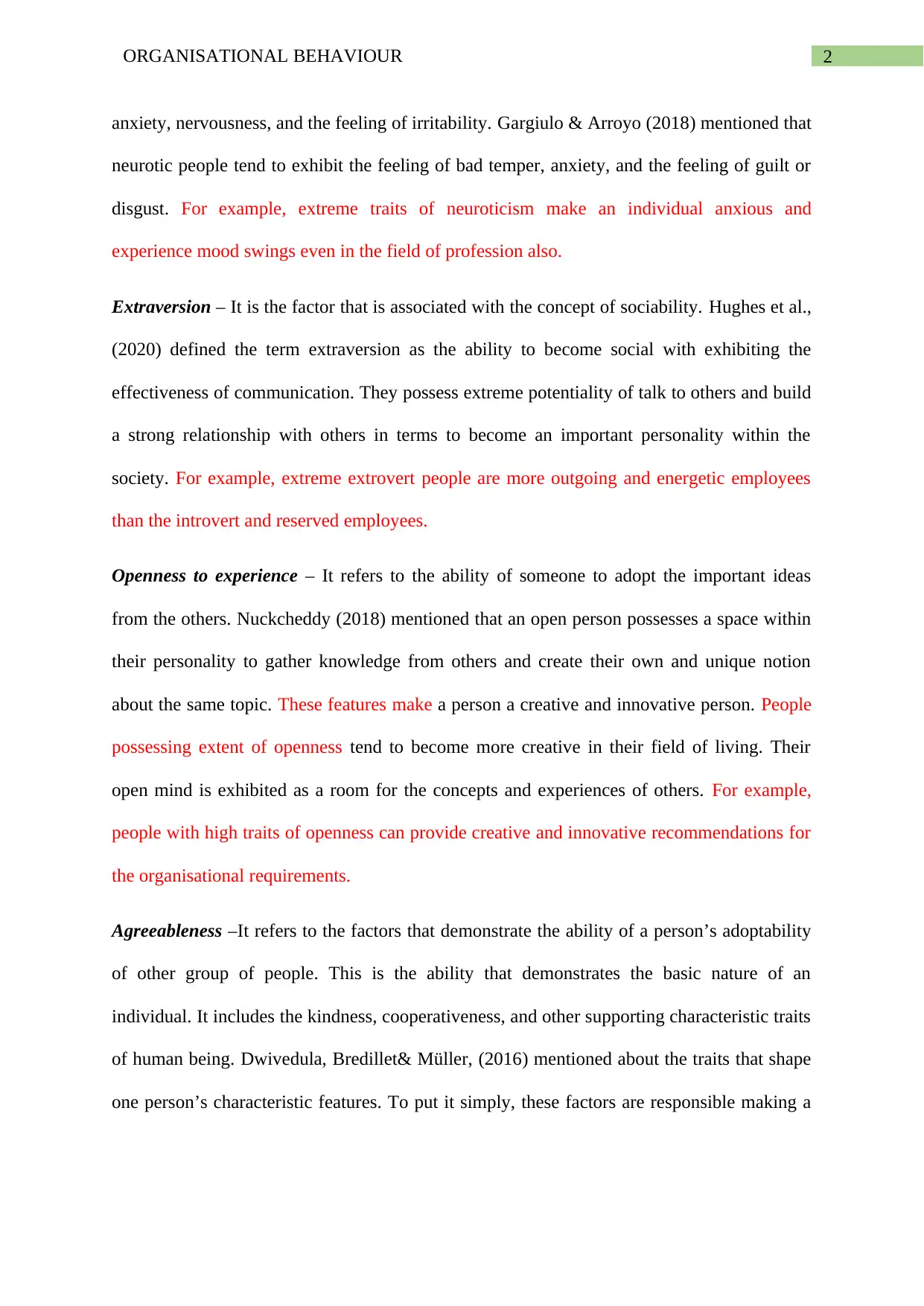
2ORGANISATIONAL BEHAVIOUR
anxiety, nervousness, and the feeling of irritability. Gargiulo & Arroyo (2018) mentioned that
neurotic people tend to exhibit the feeling of bad temper, anxiety, and the feeling of guilt or
disgust. For example, extreme traits of neuroticism make an individual anxious and
experience mood swings even in the field of profession also.
Extraversion – It is the factor that is associated with the concept of sociability. Hughes et al.,
(2020) defined the term extraversion as the ability to become social with exhibiting the
effectiveness of communication. They possess extreme potentiality of talk to others and build
a strong relationship with others in terms to become an important personality within the
society. For example, extreme extrovert people are more outgoing and energetic employees
than the introvert and reserved employees.
Openness to experience – It refers to the ability of someone to adopt the important ideas
from the others. Nuckcheddy (2018) mentioned that an open person possesses a space within
their personality to gather knowledge from others and create their own and unique notion
about the same topic. These features make a person a creative and innovative person. People
possessing extent of openness tend to become more creative in their field of living. Their
open mind is exhibited as a room for the concepts and experiences of others. For example,
people with high traits of openness can provide creative and innovative recommendations for
the organisational requirements.
Agreeableness –It refers to the factors that demonstrate the ability of a person’s adoptability
of other group of people. This is the ability that demonstrates the basic nature of an
individual. It includes the kindness, cooperativeness, and other supporting characteristic traits
of human being. Dwivedula, Bredillet& Müller, (2016) mentioned about the traits that shape
one person’s characteristic features. To put it simply, these factors are responsible making a
anxiety, nervousness, and the feeling of irritability. Gargiulo & Arroyo (2018) mentioned that
neurotic people tend to exhibit the feeling of bad temper, anxiety, and the feeling of guilt or
disgust. For example, extreme traits of neuroticism make an individual anxious and
experience mood swings even in the field of profession also.
Extraversion – It is the factor that is associated with the concept of sociability. Hughes et al.,
(2020) defined the term extraversion as the ability to become social with exhibiting the
effectiveness of communication. They possess extreme potentiality of talk to others and build
a strong relationship with others in terms to become an important personality within the
society. For example, extreme extrovert people are more outgoing and energetic employees
than the introvert and reserved employees.
Openness to experience – It refers to the ability of someone to adopt the important ideas
from the others. Nuckcheddy (2018) mentioned that an open person possesses a space within
their personality to gather knowledge from others and create their own and unique notion
about the same topic. These features make a person a creative and innovative person. People
possessing extent of openness tend to become more creative in their field of living. Their
open mind is exhibited as a room for the concepts and experiences of others. For example,
people with high traits of openness can provide creative and innovative recommendations for
the organisational requirements.
Agreeableness –It refers to the factors that demonstrate the ability of a person’s adoptability
of other group of people. This is the ability that demonstrates the basic nature of an
individual. It includes the kindness, cooperativeness, and other supporting characteristic traits
of human being. Dwivedula, Bredillet& Müller, (2016) mentioned about the traits that shape
one person’s characteristic features. To put it simply, these factors are responsible making a
⊘ This is a preview!⊘
Do you want full access?
Subscribe today to unlock all pages.

Trusted by 1+ million students worldwide
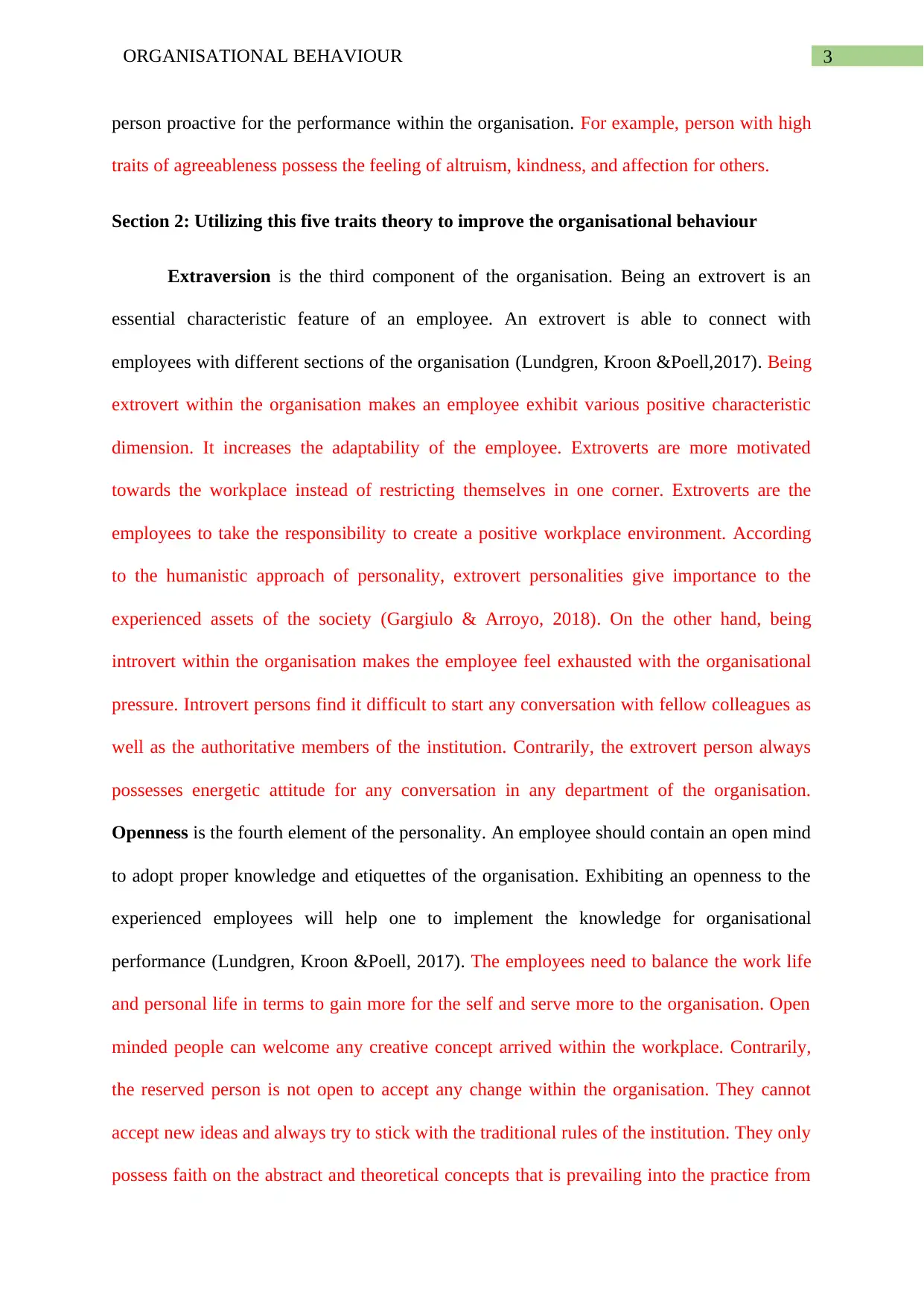
3ORGANISATIONAL BEHAVIOUR
person proactive for the performance within the organisation. For example, person with high
traits of agreeableness possess the feeling of altruism, kindness, and affection for others.
Section 2: Utilizing this five traits theory to improve the organisational behaviour
Extraversion is the third component of the organisation. Being an extrovert is an
essential characteristic feature of an employee. An extrovert is able to connect with
employees with different sections of the organisation (Lundgren, Kroon &Poell,2017). Being
extrovert within the organisation makes an employee exhibit various positive characteristic
dimension. It increases the adaptability of the employee. Extroverts are more motivated
towards the workplace instead of restricting themselves in one corner. Extroverts are the
employees to take the responsibility to create a positive workplace environment. According
to the humanistic approach of personality, extrovert personalities give importance to the
experienced assets of the society (Gargiulo & Arroyo, 2018). On the other hand, being
introvert within the organisation makes the employee feel exhausted with the organisational
pressure. Introvert persons find it difficult to start any conversation with fellow colleagues as
well as the authoritative members of the institution. Contrarily, the extrovert person always
possesses energetic attitude for any conversation in any department of the organisation.
Openness is the fourth element of the personality. An employee should contain an open mind
to adopt proper knowledge and etiquettes of the organisation. Exhibiting an openness to the
experienced employees will help one to implement the knowledge for organisational
performance (Lundgren, Kroon &Poell, 2017). The employees need to balance the work life
and personal life in terms to gain more for the self and serve more to the organisation. Open
minded people can welcome any creative concept arrived within the workplace. Contrarily,
the reserved person is not open to accept any change within the organisation. They cannot
accept new ideas and always try to stick with the traditional rules of the institution. They only
possess faith on the abstract and theoretical concepts that is prevailing into the practice from
person proactive for the performance within the organisation. For example, person with high
traits of agreeableness possess the feeling of altruism, kindness, and affection for others.
Section 2: Utilizing this five traits theory to improve the organisational behaviour
Extraversion is the third component of the organisation. Being an extrovert is an
essential characteristic feature of an employee. An extrovert is able to connect with
employees with different sections of the organisation (Lundgren, Kroon &Poell,2017). Being
extrovert within the organisation makes an employee exhibit various positive characteristic
dimension. It increases the adaptability of the employee. Extroverts are more motivated
towards the workplace instead of restricting themselves in one corner. Extroverts are the
employees to take the responsibility to create a positive workplace environment. According
to the humanistic approach of personality, extrovert personalities give importance to the
experienced assets of the society (Gargiulo & Arroyo, 2018). On the other hand, being
introvert within the organisation makes the employee feel exhausted with the organisational
pressure. Introvert persons find it difficult to start any conversation with fellow colleagues as
well as the authoritative members of the institution. Contrarily, the extrovert person always
possesses energetic attitude for any conversation in any department of the organisation.
Openness is the fourth element of the personality. An employee should contain an open mind
to adopt proper knowledge and etiquettes of the organisation. Exhibiting an openness to the
experienced employees will help one to implement the knowledge for organisational
performance (Lundgren, Kroon &Poell, 2017). The employees need to balance the work life
and personal life in terms to gain more for the self and serve more to the organisation. Open
minded people can welcome any creative concept arrived within the workplace. Contrarily,
the reserved person is not open to accept any change within the organisation. They cannot
accept new ideas and always try to stick with the traditional rules of the institution. They only
possess faith on the abstract and theoretical concepts that is prevailing into the practice from
Paraphrase This Document
Need a fresh take? Get an instant paraphrase of this document with our AI Paraphraser
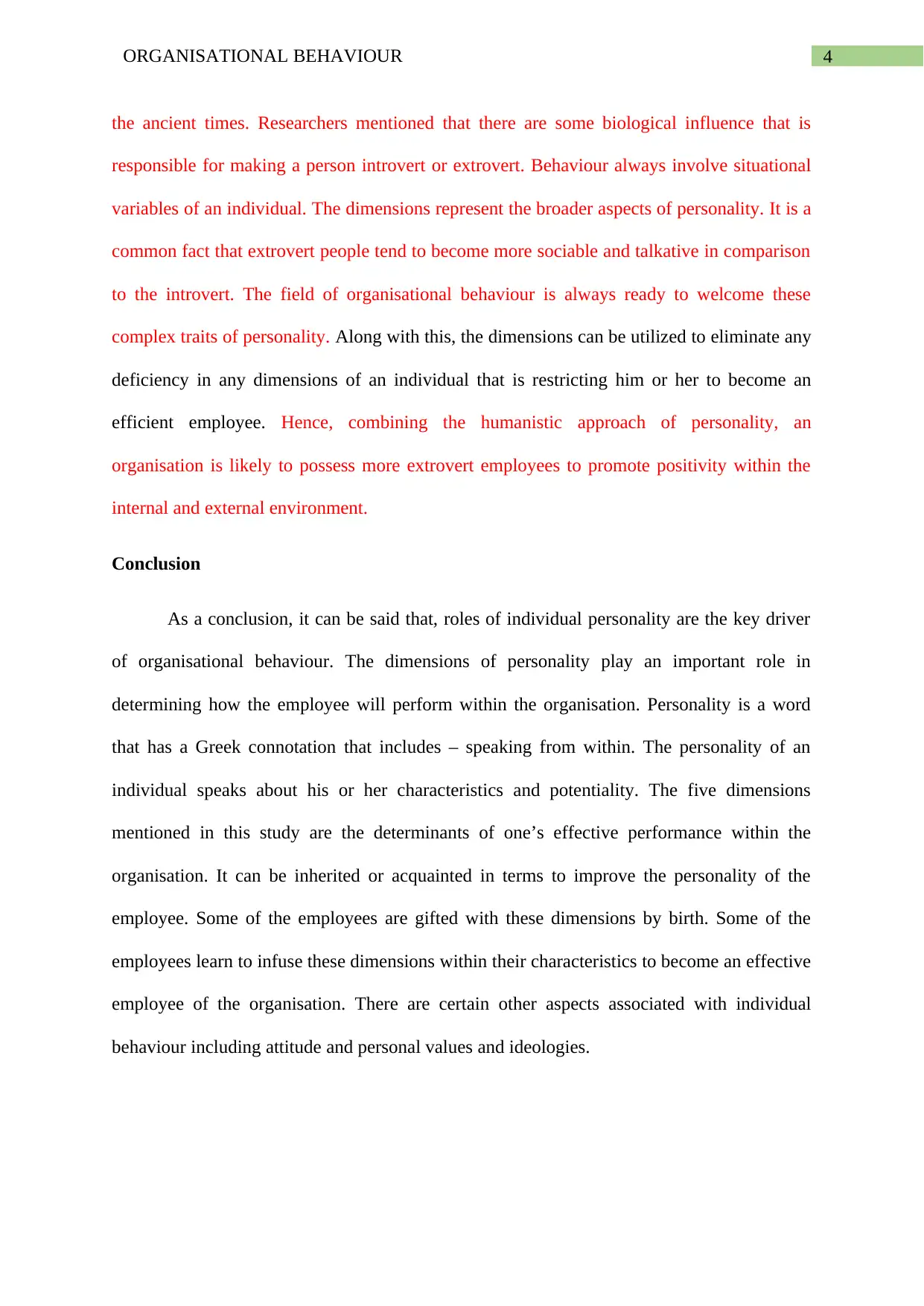
4ORGANISATIONAL BEHAVIOUR
the ancient times. Researchers mentioned that there are some biological influence that is
responsible for making a person introvert or extrovert. Behaviour always involve situational
variables of an individual. The dimensions represent the broader aspects of personality. It is a
common fact that extrovert people tend to become more sociable and talkative in comparison
to the introvert. The field of organisational behaviour is always ready to welcome these
complex traits of personality. Along with this, the dimensions can be utilized to eliminate any
deficiency in any dimensions of an individual that is restricting him or her to become an
efficient employee. Hence, combining the humanistic approach of personality, an
organisation is likely to possess more extrovert employees to promote positivity within the
internal and external environment.
Conclusion
As a conclusion, it can be said that, roles of individual personality are the key driver
of organisational behaviour. The dimensions of personality play an important role in
determining how the employee will perform within the organisation. Personality is a word
that has a Greek connotation that includes – speaking from within. The personality of an
individual speaks about his or her characteristics and potentiality. The five dimensions
mentioned in this study are the determinants of one’s effective performance within the
organisation. It can be inherited or acquainted in terms to improve the personality of the
employee. Some of the employees are gifted with these dimensions by birth. Some of the
employees learn to infuse these dimensions within their characteristics to become an effective
employee of the organisation. There are certain other aspects associated with individual
behaviour including attitude and personal values and ideologies.
the ancient times. Researchers mentioned that there are some biological influence that is
responsible for making a person introvert or extrovert. Behaviour always involve situational
variables of an individual. The dimensions represent the broader aspects of personality. It is a
common fact that extrovert people tend to become more sociable and talkative in comparison
to the introvert. The field of organisational behaviour is always ready to welcome these
complex traits of personality. Along with this, the dimensions can be utilized to eliminate any
deficiency in any dimensions of an individual that is restricting him or her to become an
efficient employee. Hence, combining the humanistic approach of personality, an
organisation is likely to possess more extrovert employees to promote positivity within the
internal and external environment.
Conclusion
As a conclusion, it can be said that, roles of individual personality are the key driver
of organisational behaviour. The dimensions of personality play an important role in
determining how the employee will perform within the organisation. Personality is a word
that has a Greek connotation that includes – speaking from within. The personality of an
individual speaks about his or her characteristics and potentiality. The five dimensions
mentioned in this study are the determinants of one’s effective performance within the
organisation. It can be inherited or acquainted in terms to improve the personality of the
employee. Some of the employees are gifted with these dimensions by birth. Some of the
employees learn to infuse these dimensions within their characteristics to become an effective
employee of the organisation. There are certain other aspects associated with individual
behaviour including attitude and personal values and ideologies.
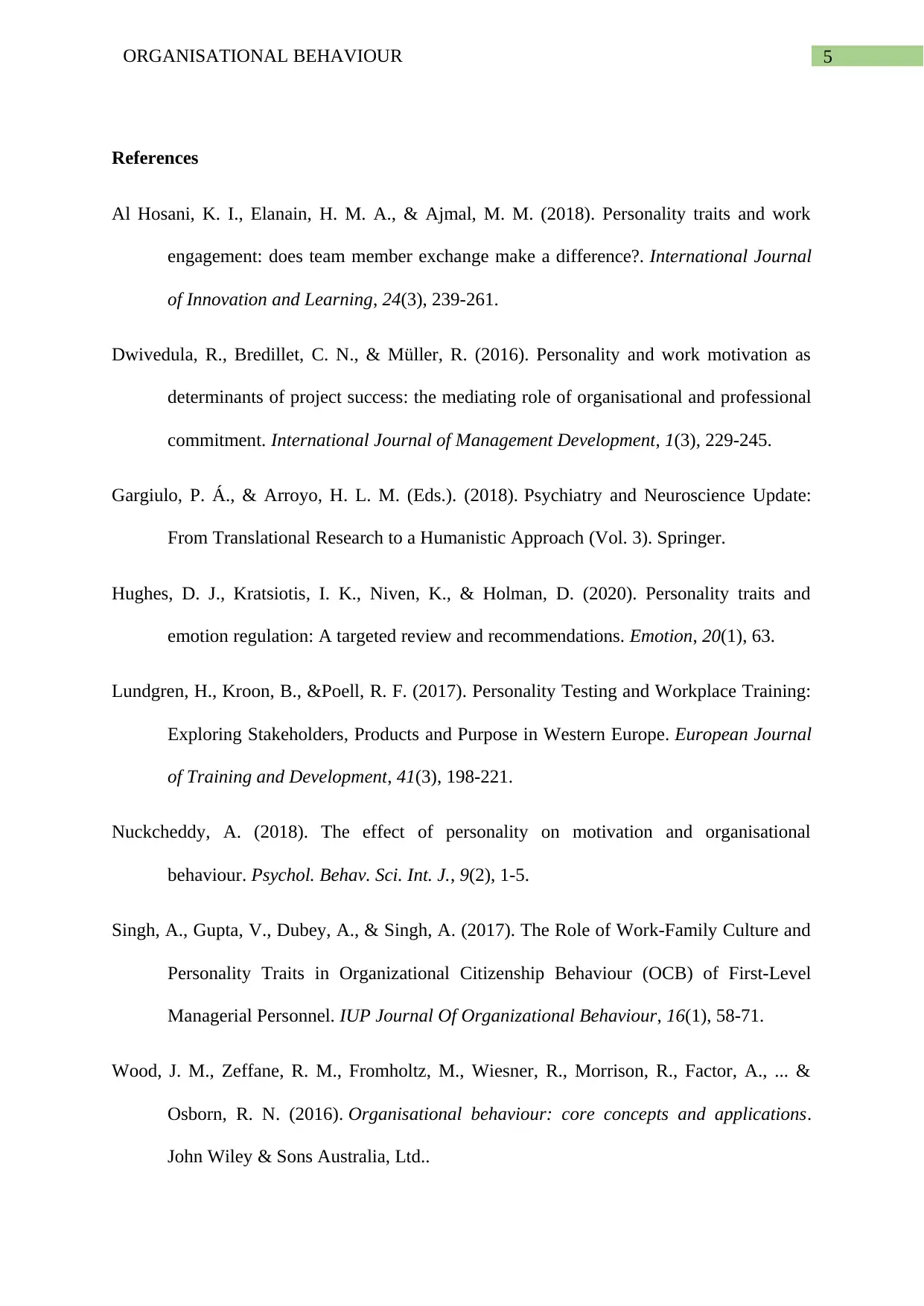
5ORGANISATIONAL BEHAVIOUR
References
Al Hosani, K. I., Elanain, H. M. A., & Ajmal, M. M. (2018). Personality traits and work
engagement: does team member exchange make a difference?. International Journal
of Innovation and Learning, 24(3), 239-261.
Dwivedula, R., Bredillet, C. N., & Müller, R. (2016). Personality and work motivation as
determinants of project success: the mediating role of organisational and professional
commitment. International Journal of Management Development, 1(3), 229-245.
Gargiulo, P. Á., & Arroyo, H. L. M. (Eds.). (2018). Psychiatry and Neuroscience Update:
From Translational Research to a Humanistic Approach (Vol. 3). Springer.
Hughes, D. J., Kratsiotis, I. K., Niven, K., & Holman, D. (2020). Personality traits and
emotion regulation: A targeted review and recommendations. Emotion, 20(1), 63.
Lundgren, H., Kroon, B., &Poell, R. F. (2017). Personality Testing and Workplace Training:
Exploring Stakeholders, Products and Purpose in Western Europe. European Journal
of Training and Development, 41(3), 198-221.
Nuckcheddy, A. (2018). The effect of personality on motivation and organisational
behaviour. Psychol. Behav. Sci. Int. J., 9(2), 1-5.
Singh, A., Gupta, V., Dubey, A., & Singh, A. (2017). The Role of Work-Family Culture and
Personality Traits in Organizational Citizenship Behaviour (OCB) of First-Level
Managerial Personnel. IUP Journal Of Organizational Behaviour, 16(1), 58-71.
Wood, J. M., Zeffane, R. M., Fromholtz, M., Wiesner, R., Morrison, R., Factor, A., ... &
Osborn, R. N. (2016). Organisational behaviour: core concepts and applications.
John Wiley & Sons Australia, Ltd..
References
Al Hosani, K. I., Elanain, H. M. A., & Ajmal, M. M. (2018). Personality traits and work
engagement: does team member exchange make a difference?. International Journal
of Innovation and Learning, 24(3), 239-261.
Dwivedula, R., Bredillet, C. N., & Müller, R. (2016). Personality and work motivation as
determinants of project success: the mediating role of organisational and professional
commitment. International Journal of Management Development, 1(3), 229-245.
Gargiulo, P. Á., & Arroyo, H. L. M. (Eds.). (2018). Psychiatry and Neuroscience Update:
From Translational Research to a Humanistic Approach (Vol. 3). Springer.
Hughes, D. J., Kratsiotis, I. K., Niven, K., & Holman, D. (2020). Personality traits and
emotion regulation: A targeted review and recommendations. Emotion, 20(1), 63.
Lundgren, H., Kroon, B., &Poell, R. F. (2017). Personality Testing and Workplace Training:
Exploring Stakeholders, Products and Purpose in Western Europe. European Journal
of Training and Development, 41(3), 198-221.
Nuckcheddy, A. (2018). The effect of personality on motivation and organisational
behaviour. Psychol. Behav. Sci. Int. J., 9(2), 1-5.
Singh, A., Gupta, V., Dubey, A., & Singh, A. (2017). The Role of Work-Family Culture and
Personality Traits in Organizational Citizenship Behaviour (OCB) of First-Level
Managerial Personnel. IUP Journal Of Organizational Behaviour, 16(1), 58-71.
Wood, J. M., Zeffane, R. M., Fromholtz, M., Wiesner, R., Morrison, R., Factor, A., ... &
Osborn, R. N. (2016). Organisational behaviour: core concepts and applications.
John Wiley & Sons Australia, Ltd..
⊘ This is a preview!⊘
Do you want full access?
Subscribe today to unlock all pages.

Trusted by 1+ million students worldwide
1 out of 6
Related Documents
Your All-in-One AI-Powered Toolkit for Academic Success.
+13062052269
info@desklib.com
Available 24*7 on WhatsApp / Email
![[object Object]](/_next/static/media/star-bottom.7253800d.svg)
Unlock your academic potential
Copyright © 2020–2025 A2Z Services. All Rights Reserved. Developed and managed by ZUCOL.





